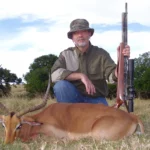Mark Drury explains the key factors that influence whitetail behavior, advice for beginning hunters and the benefits of onX Hunt and his new DeerCast hunting app.
What if the forecast could tell you where the whitetail will be the night before you head out into the field? What if you could look at a new swath of public hunting ground and know intuitively where the whitetail will be?
Missouri-based Mark Drury, co-owner of Drury Outdoors and a lifetime hunter with 40+ years of whitetail hunting experience, is a firm believer that it’s possible. In his “Thirteen” video series, he talks about 13 different indicators that dictate whitetail behavior and patterning. In a recent phone interview with onX, he noted three factors he always looks for when evaluating a potential hunting location:
– Bed- Food- Water
Food, he reiterated, is perhaps the most important factor.
“Whitetail are slaves to their stomachs,” he shared. “Really focus on your food plots. Befriend a local farmer or someone at the local co-op—they will know crop timing, what sprays and fertilizers to use and more.” That farmer or co-op member may end up being your best friend in the plot-planning game. Consider possibly calling up your local Farm Service Agency office and asking for information; usually they are more than happy to help.
Food is a moving target: a whitetail’s preferred source differs by both region and time of year and can also change on a day-by-day basis. If a deer is feeding on beans and then acorns suddenly start to drop, they’re likely to shift to eating acorns, therefore changing current eating habits and—most likely—movement patterns.
Mark is a steady user of onX Hunt as a tool to manage his food plots. “I absolutely love onX,” he shared. “I like using it to establish the size on all of my food plots. By calculating the correct acreages, it really helps estimate seed and fertilizer needs, which helps reduce costs. No need to guess anymore.”
Pending the time of year, a good water source and potential bedding spots may overtake the need for food.
“At certain times of year, water, food or bed may be the most important,” Mark noted. It’s up to the hunter to problem solve in certain areas—and to look for opportunities. “If they’re lacking cover or food, you can help provide it.”
Another crucial factor for whitetail hunters is weather. “It’s a big one,” commented Mark. “Weather influences whitetail behavior and movement on a minute-by-minute basis.” It’s this level of importance that helped inspire Mark, along with his brother Terry, to develop the DeerCast hunting app. It also inspired us to create our own deer hunting weather and forecasting capability in onX Hunt. Utilizing current weather reports and weather forecasting, DeerCast helps whitetail hunters predict deer movement in the field.
One of the last key factors Mark looks at is overall rut interpretation and dynamics. What does the herd ratio look like? For example, a high doe-to-buck ratio can lead to a prolonged, less-defined rut. Take some time to research the herd you’re hoping to hunt—game cameras are your friend here.
And perhaps most of all: don’t be afraid to get your hands dirty and just learn. As a child, Mark lived in a rural town of roughly 400 residents. His father didn’t hunt, but he knew he wanted to be outside.
“Since the time I was little I just wanted to be in the woods,” he shared. “I took up hunting myself—that’s just what people did in our town; how they approached things. It was a lot of learning by trial-and-error.”
It was that same learning process that has now led to a 40-plus-year career as a whitetail hunter. “Hunters can never stop learning; you need to go at it with an open mind—hunting keeps us learning,” Mark added.
That same spirit of learning dictates the hunting lifestyle, for both first-year and seasoned hunters. Mark notes that 25 years ago, hunting media was largely limited to print magazines such as Field & Stream and Outdoor Life; now it’s easy to find all manner of information online.
His advice for new hunters? “Sit there and soak up as much as possible online—and never stop wanting to learn.”
It’s savvy advice for hunters of all levels, backgrounds, and locales.
header image: Donn Vidosh











































